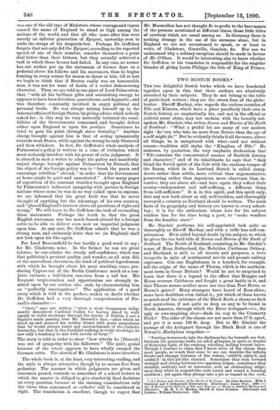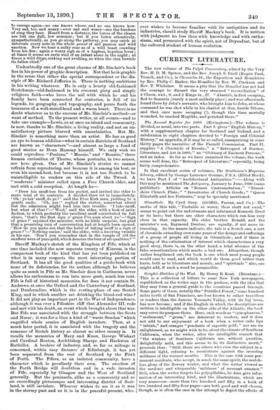TWO SCOTCH BOOKS.*
THE two delightful Scotch Woks which we have bracketed together agree in this, that their authors are absolutely absorbed by their subjects. They do not belong to the tribe of guide-book writers ; they are the sworn foes of the globe- trotter. Sheriff Mackay, who regards the curious counties of Fife and Kinross, which have a place' peculiarly their own in
Scotch history, as emphatically his, and not in the official or judicial sense alone, may not exclaim with the breezily out- spoken Mr. Sinclair; who writes Scenes and Stories of the North of Scotland : " What a pitiful lot are many of our modern sight do'-ere, who take no more from Nature than the eye of a calf might do!" But he evidently thinks it all the same; above all things, he is enraptured with what—and not without reason—tradition still styles the "Kingdom of Fife." He endorses, by quotation, the very emphatic declaration that "Fife contains the concentrated essence of Scottish history and character ;" and of its inhabitants he says that " they blend the fervid spirit of the Celt with the cautious temper of the Saxon, which in its Lowland Scotch is called canny.
Acute rather than subtle, more critical than argumentative, persevering rather than ingenious, more observant than in- ventive, they are above all—and here again they reflect their county—independent and self-sufficing, a different thing from self-sufficient." It is in this spirit, and this spirit only, that any new book about so old, well-trodden, and thoroughly surveyed a country as Scotland should be written. The main facts of its geography and history are known to every school- boy ; it is for the enthusiast, whose love for his subject renders him for the time being a poet, to "make wonders from the familiar start."
Mr. Sinclair performs his self-appointed task quite as thoroughly as Sheriff Mackay, and with a trifle less self-con- sciousness. Heis aided beyond doubt by his subject, to which he gives the too bald title of Scenes and Stories of the North of Scotland. The North of Scotland, consisting, in Mr. Sinclair's sense, of Ross, Sutherland, the Hebrides, Caithness, Orkney, and Shetland, is still, to all intents and purposes, a terra incognita, in spite of sentimental novels and prosaic railway expresses. Can one Englishman in a hundred, for example, tell the origin of the name of Thurso, which is the northern- most town in Great Britain P Would he not be surprised to learn that there is a legend to the effect that Hengist and Horsa overran Caithness and fought a great battle in it, and that Thurso means neither more nor less than Tout Horsa, or Horsa's .grave P Many strangers have heard of Ross-shire ; some have doubtless even visited it ; yet which of them knows so much as of the existence of the Black Rock, a chasm as dark and mysterious, if not quite as deep as any to be found in
North America, through which the River Aultgaart—i.e., the ugly or awe-inspiring river—finds its way to the Cromarty Firth P The sides of the chasm are not more than 17 ft. apart,
and yet it is some 130 ft. deep. But to Mr. Sinclair the passage of the Aultgaart through the Black Rock is one of Nature's 2Eschylea,n tragedies :—
" Peering downwards into the darkness far, far beneath our feet, between the gruesome walls, we catch glimpses, in spots or streaks of flickering light, of the rushing, whirling, boiling torrent below. Though I venture to claim that I know more of the chasm than most people, no words that come to me can describe the infinite freaks and strange fortunes of the waters, cribb'd, cabin'd, and confin'd ' in this pit-like channel. Sometimes they rush forward straight and strong between two opposing ledges ; sometimes they stumble, suddenly and at unawares, over an obstructing ridge; anon they whirl in serpent-like coils round and round a foaming cauldron ; yet again they plunge into a pit or tunnel in the rock,
• (1.) Scenes and Stories of the North of ScIttand. By John Sinclair. With 3 Coloured and 8 Lithograph Illustrations. Edinburgh : James Thin. 1890.- (2.) A Sketch of the History of Fife and Kinross : a Study in Scottish History and
Character. By 2B. J. Mackay, Sheriff of these Counties. Edinburgh and London : William Blackwood. 1890. to emerge again—no one knows where, and no one knows how. -Very sad, too, and weary—ever sad and weary—are the burdens of song they bear. Heard from a distance, the voices of the chasm are but one dull, low murmur; but if you listen attentively, sympathetically, as you go along the pathway, you may catch at intervals every note in the whole gamut of sad passion and wild emotion. Now we hear a sulky roar as of a wild beast crawling from his den ; again a weary sigh as of a hapless, hopeless lover ; at times it seems an eerie wail of an infant alone in the night ; at times a wild dirge, sinking and swelling, as when the clan bewails its fallen chief."
Undoubtedly one of the great charms of Mr. Sinclair's book lies in his power of graphic description. Not that he is graphic in the sense that either the special correspondent or the dis- ciple of Mr. Richard Jefferies is. There is nothing ambitious in his writing whatever. He is only a hearty old-fashioned Scotchman—old-fashioned in his reverent piety and simple religious faith—who loves the soil with which he and his family have been connected for centuries, is full of its legends, its geography, and topography, and pours forth the treasures of a well-stored head and a warm heart. There is no doubt whatever as to the success of Mr. Sinclair's method—or want of method. To the present writer, at all events—and to take one example—Lewis, as at once an island and community, is now, thanks to Mr. Sinclair, a living reality, and not an =- satisfactory picture blurred with uncertainties. But Mr. Sinclair is something more than an artist. He has as good an eye to human oddities—what in certain districts of Scotland are known as " characters "—and almost as large a fund of good stories as Dean Ramsay himself. We only wish we could reproduce " Peela.ns," " Moozie," and " Boustie," three human curiosities of Thurso, whose portraits, in two senses, are here given. One of Mr. Sinclair's stories we cannot refrain from reproducing, not because it is among his best, or even his second-best, but because it is not too Scotch to be unintelligible to readers on this side of the Tweed. A -" moderate " minister called upon a Free Church elder, and met with a cold reception. At length he- " Drew his snuff-box from his pocket, and invited the elder to make trial of its contents. A decided thaw set in immediately. " Oh ! ye tak' snuff, do ye ? ' said the Free Kirk man, yielding to a
gentle smile. Oh, yes ! ' replied the visitor, somewhat afraid Zest the admission might lead him into trouble. I take snuff, but what of that?'—' Weel,' said the elder, with a look of satis- faction, to which probably the excellent snuff contributed its full share, 'that's the first sign o' grace I've seen aboot ye.'—' Sign of grace ?' rejoined the minister, with no little surprise, but glad that a promising vein of conversation had at length been opened. How do you make out that the habit of taking snuff is a sign of grace ? Nothing easier,' said the elder, with a knowing twinkle in his eye. 'Don't you remember that in the temple of old the snuffers were of pure gold, which denotes the best of all qualities ?' "
Sheriff Mackay's sketch of the Kingdom of Fife, which at one time included the now separate county of Kinross, is the eompactest book of the kind that has yet been published on what is in many respects the most interesting portion of Scotland. It has all the good qualities of a guide-book with none of its deficiencies, for its author, although he believes quite as much in Fife as Mr. Sinclair does in Caithness, never allows his enthusiasm to run into mere gush, much less rant. Fife is full of historical memories, for does it not contain St. Andrews, at once the Oxford and the Canterbury of Scotland, and Dunfermline, which is the resting-place of one Scotch King, and in which another sat drinking the blood-red wine P It did not play-an important part in the War of Independence, although it was over a Fifeshire cliff that Alexander III. rode and met with his death, an event which brought about that war. But Fife was associated with the struggle between the Scots and Norse ; it was for a time a kind of " waste Soudan " which engulfed whole armies of English invaders. Then, at a much later period, it is associated with the tragedy and the romance of Scotch history as almost no other county is. It recalls the memories of Mary and Knox, George Wishful and Cardinal Beaton, Archbishop Sharpe and Hackston of Rathillet. A beehive of industry, and, so far as mileage is concerned, within easy distance of Edinburgh, it has yet been separated from the rest of Scotland by the Firth of Forth. The Fifers, as an isolated community, have a character which is peculiarly their own. The erection of the Forth Bridge will doubtless end in a rude invasion of- Fife, especially by Glasgow and the West of Scotland generally. But the peninsula, alike as a community and as an exceedingly picturesque and interesting district of Scot- land, is still inviolate. Whoever wishes to see it as it was in the stormy past and as it is in the peaceful present, who-
ever wishes to become familiar with its antiquities and its industries, should study Sheriff Mackay's book. It is written with judgment no less than with knowledge and with enthu- siasm, and permeated with the spirit, not of Dryasdust, but of the cultured student of human evolution.







































 Previous page
Previous page